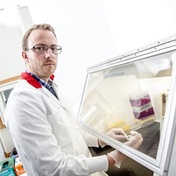Financial institutions continue to teeter on the brink of ruin. Banks are still devouring bailout money without loosening credit enough to make a difference in a recession that is sweeping the globe.
A new Northwestern University study provides provocative insights that relate to, if not answer, an extraordinarily complex question: How do financial titans take such huge risks?
The study, for the first time, links specific variants of two genes that regulate dopamine and serotonin neurotransmission to risk-taking in financial investment decisions.
Study first of its kind
Northwestern students were given real money to make a series of investments, in each trial deciding how to allocate money between a risky and a risk-free asset.
People with the short serotonin transporter gene, 5-HTTLPR (two copies of the short allele), relative to those with the long version of that polymorphism (at least one copy of the long allele), invested 28% less in a risky investment. Similarly, people who carry the 7-repeat allele of the DRD4 gene in the dopamine family, relative to those carrying other versions of that gene, invested about 25% more in a risky investment.
"Our research pinpoints, for the first time, the roles that specific variants of the serotonin transporter gene and the dopamine receptor gene play in predicting whether people are more or less likely to take financial risks," said Camelia M Kuhnen, assistant professor of finance, Kellogg School of Management at Northwestern. "It shows that individual variability in our genetic makeup affects economic behaviour."
"Genetic Determinants of Financial Risk Taking" will be published by the open-access journal PLoS ONE. The study's co-investigators are Kuhnen and Joan Y Chiao, assistant professor of psychology at Northwestern.
Genes also linked to addiction
Prior research linking the two genetic variants of 5-HTTLPR and DRD4 to, respectively, negative emotion and addiction behaviours suggested to the Northwestern researchers that those particular brain mechanisms could play a role in financial risk-taking. But until the Northwestern study, the identification of specific genes underlying financial-risk preferences remained elusive.
The study included 65 subjects (26 of which were male, and the average age was 22 years). Study participants completed 96 computer trials in an experiment designed to give them background information with which to make decisions between pairs of risky and risk-free investments. They were told the sure rate of return for the risk-free asset and the two possible rates of return for the risky asset, which were equally likely to occur. Typically, the risk-free asset return was close to 3%, while the two possible outcomes of the risky asset return were, for example, 20% and 10%, respectively.
Participants initially were given $15, but received additional funds for each of the 96 investment decisions. They allocated their funds between the two assets in each trial, but were not told the performance of their portfolios (how much money they were making or losing) until the end of the exercise. The entire experiment took 1.5 hours to complete, and the average pay per subject was $25.
Advances in neuroscience
As predicted by finance theory, participants invested significantly more money in the risky asset if its expected return was higher, the standard deviation of its return was lower, or if the return of the safe asset was lower. Also the higher the amount available to participants, the more money they invested in the risky asset.
Following the investment tasks, genotyping was conducted to identify the 5-HTTLPR and DRD4 polymorphisms. Investigators collected saliva from each participant, and DNA was isolated and genotyped.
The Northwestern researchers were able to take advantage of advances in neuroscience methodology as well as emerging research on the two neurotransmitters' effects on decision-making.
"Emerging research told us, for example, that people higher in neuroticism are thought to carry the short allele of the 5-HTTLPR, a less efficient version of the serotonin transporter gene," said Chiao. "Similarly, individuals with the 7-repeat allele of DRD4, relative to those with other variants of that neurotransmitter, are more likely to have higher novelty seeking behaviour."
Genes underlying social behaviour
The Northwestern study suggests that researchers are getting closer to pinpointing specific genetic mechanisms underlying complex social and economic behaviour that has been a mystery - including drug addiction, gambling and risk-taking.
"As we sort through the devastating consequences of this financial crisis, it might be useful to note how our genetic heritage is influencing our economic behaviour," said Chiao. "Think about how the excessive risks taken by just a few affected so many, from large institutions to average people."
But, Kuhnen cautions, more research is needed to further understand investor behaviour, given the complex influences of nature versus nurture on financial decisions. Less than 30% of variation across people in risk-taking comes from genetics. The rest comes from experience and upbringing.
"Keep in mind," Kuhnen said, "that risk-taking in the marketplace may be the result of the genetic makeup of traders and investors, their past experiences in the stock market or their cultural background." – (EurekAlert!)
Read more:
Popularity determined by genes
Genes tied to schizophrenia found
February 2009




 Publications
Publications
 Partners
Partners














